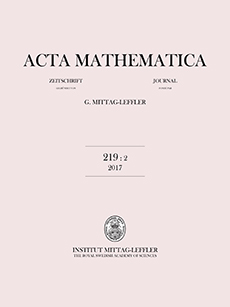Abstract
In this paper we study surfaces in R3 that arise as limit shapes in random surface models related to planar dimers. These limit shapes are surface tension minimizers, that is, they minimize a functional of the form ∫σ(∇h) dxdy among all Lipschitz functions h taking given values on the boundary of the domain. The surface tension σ has singularities and is not strictly convex, which leads to formation of facets and edges in the limit shapes.
We find a change of variables that reduces the Euler–Lagrange equation for the variational problem to the complex inviscid Burgers equation (complex Hopf equation). The equation can thus be solved in terms of an arbitrary holomorphic function, which is somewhat similar in spirit to Weierstrass parametrization of minimal surfaces. We further show that for a natural dense set of boundary conditions, the holomorphic function in question is, in fact, algebraic. The tools of algebraic geometry can thus be brought in to study the minimizers and, especially, the formation of their singularities. This is illustrated by several explicitly computed examples.
Citation
Richard Kenyon. Andrei Okounkov. "Limit shapes and the complex Burgers equation." Acta Math. 199 (2) 263 - 302, 2007. https://doi.org/10.1007/s11511-007-0021-0
Information





